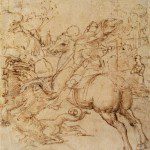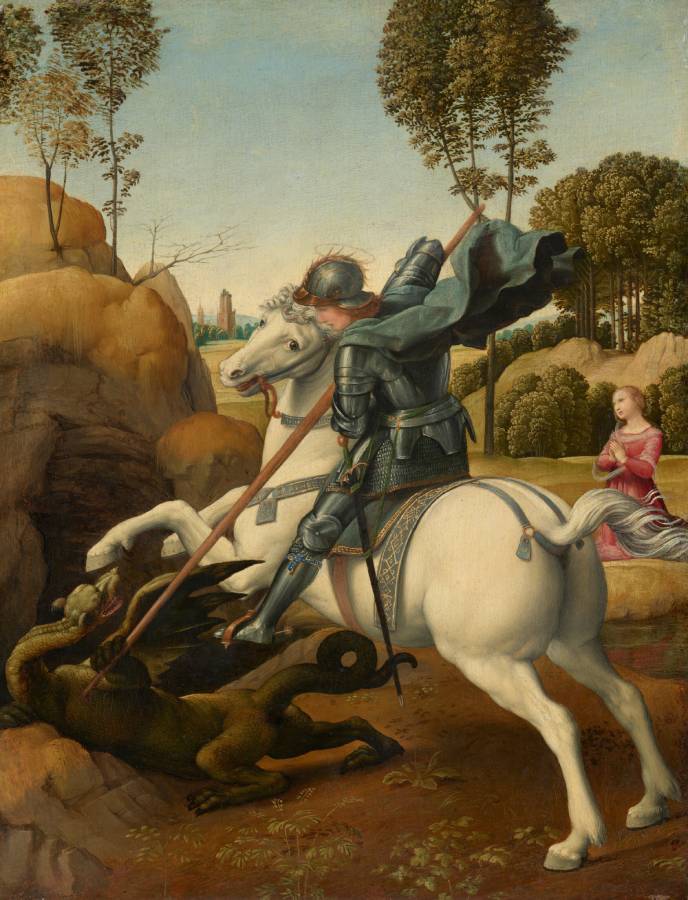Raffaello (1483-1520)
San Giorgio e il drago (Saint George and the Dragon)
c.1506
Oil on panel, 28.5 x 21.5 cm
National Gallery of Art, Washington
Raphael was born in Urbino, a central Italian duchy noted for its elegant gentility and Renaissance scholarship. He moved to Florence toward the end of 1504. Saint George and the Dragon, one of two versions of the theme by the artist, belonged to a series of miniature panels that Raphael painted in Florence for the celebrated court of Urbino. A Roman soldier of Christian faith, Saint George saved the daughter of a pagan king by subduing a dragon with his lance; the princess then led the dragon to the city, where the saint killed it with his sword, prompting the king and his subjects to convert to Christianity. One unusual feature of the painting is the saint’s blue garter on his armor–covered leg. Its inscription, HONI, begins the phrase Honi soit qui mal y pense (Disgraced be he who thinks ill of it), the motto of the chivalric Order of the Garter, of which George is the patron saint. Duke Guidobaldo da Montefeltro of Urbino was made a knight of the prestigious order in 1504 by King Henry VII of England. Scholarship has shown that the panel was made for the king’s emissary, Gilbert Talbot, and not as a gift directly for the king, as was previously thought. A man wearing armor, sitting astride a cream-white horse, drives a long lance down at a lizard-like dragon as a woman kneels with her hands in prayer in the landscape beyond in this vertical painting. Both people have pale skin and thin, gold halos floating above their heads. At the center of the composition, the man faces our left in profile as he looks down at the creature. The man has a straight nose and honey-brown hair under his gold-trimmed, pewter-gray helmet. Armor covers his entire body, and a celestial-blue cape billows behind him from where it fastens around his neck. A narrow, indigo-blue and gold band is tied around his left calf, and is inscribed with the word “HONI.” A black sword hangs from his left side. The horse is white with a silvery-white mane and tail. It rears on its hind legs as it turns its head to look at us with hazel-brown eyes. The horse wears a blue saddle and bridle, the same color as the man’s cape, trimmed with gold. A strap around the horse’s neck is painted in gold with the name, “RAPHELLO.” The rider thrusts his foot into the stirrup we can see as he plunges a lance down at the dragon under the horse’s front feet. The dragon has tawny brown skin with a mint green, dog-like head. It grips the earth with clawed feet as at pushes at the lance with one front foot. It twists its long, snake-like neck to look at the man with dark eyes. The dragon opens its pointed snout to show its teeth, and bat-like wings splay out. A tall outcropping over a cave rises along the left edge of the composition, behind the dragon. In a field a little farther back, to our right, the woman kneels with her body angled to our left. She tilts her head away from us and gazes past the man and horse. She has a straight nose, pale pink, bow-shaped lips, and her blond hair is pulled back in a bun. She wears a ruby-red dress and a sheer white wrap around her shoulders and across her arms. Around the woman, straw-yellow hills with bands of pine-green trees roll into the distance. Two terracotta-orange towers rise from a row of trees along the horizon. A few taller trees are outlined against the baby-blue sky, which lightens toward the horizon. (NGA)
See also:
 Raffaello (1483-1520)
Raffaello (1483-1520)
San Giorgio uccide il drago
c.1506
Galleria degli Uffizi, Firenze
